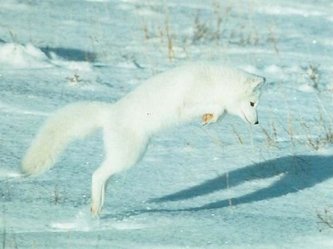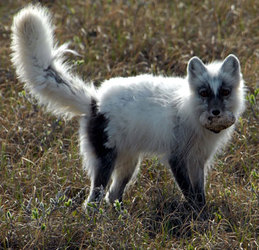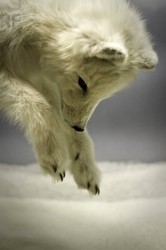Diet & Behavior
Diet
Surprisingly, Arctic Foxes are omnivores. They feed on lemmings, voles, Arctic Hares, birds and their eggs, and carrion. A famiy of Arctic Foxes can eat dozens of lemmings every day! Fish under the surface of ice are also part of their diet. During April and May, they feed on the Ringed Seal pups that are helpless and confined to their dens. Any extra food they may have is buried and saved for when it is needed, and when meat is not available to them, Arctic Foxes may also eat fruit and berries. When food is scarce, Arctic Foxes may even eat the leftovers of other animals' meals. The Arctic Fox's diet is varied.
Arctic Foxes locate their prey under the snow, and then capture, kill, and consume it. They walk along the snow, listening with their sensitive hearing. Once an Arctic Fox locates a small animal, it will either dig it up or jump on the snow in order to break through so that it can access the prey hidden beneath.
Arctic Foxes locate their prey under the snow, and then capture, kill, and consume it. They walk along the snow, listening with their sensitive hearing. Once an Arctic Fox locates a small animal, it will either dig it up or jump on the snow in order to break through so that it can access the prey hidden beneath.
Behavior
Arctic Foxes are nomadic within a home range, moving from place to place in search of food. A male's home range is larger than a female's. Arctic Foxes do not hibernate, so they are able to produce up to two litters a year. A litter consists of up to as many as 15 kits. The mating and birthing season is between September and May. They have a gestation period of approxiamately 49-57 days. In the summer, they live in family groups made up of a male, one or two females, and the kits. The second female is a leftover kit from the previous season and doesn't mate, but helps to raise the young. Arctic Foxes bark to communicate with each other. Studies show that they can distinguish the difference between the barks of members and non-members of their family group. They have a life span of 12 years.






